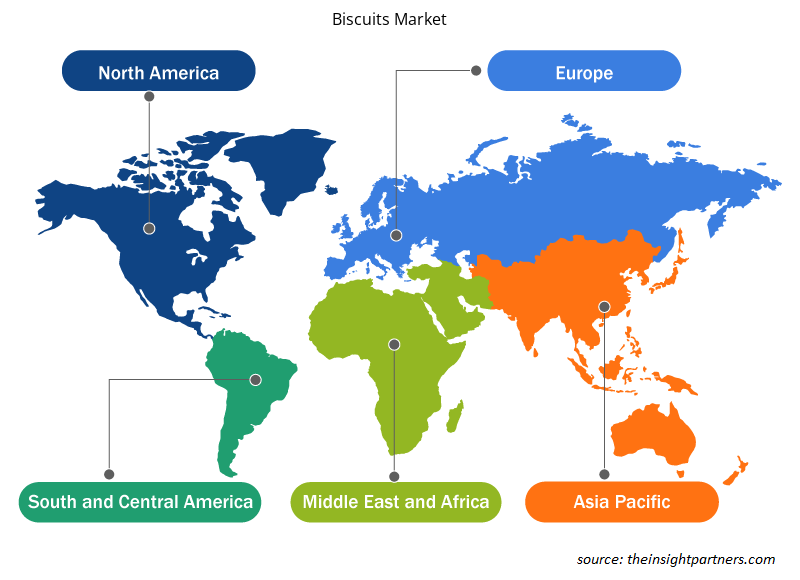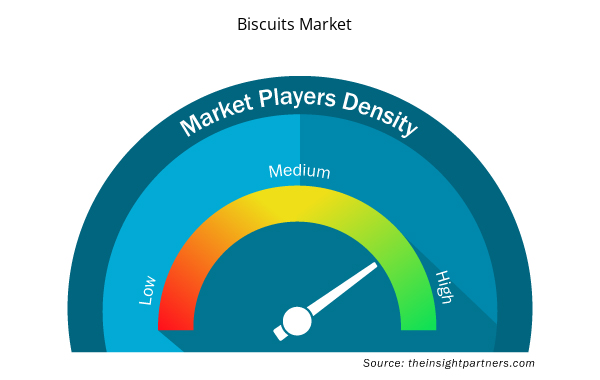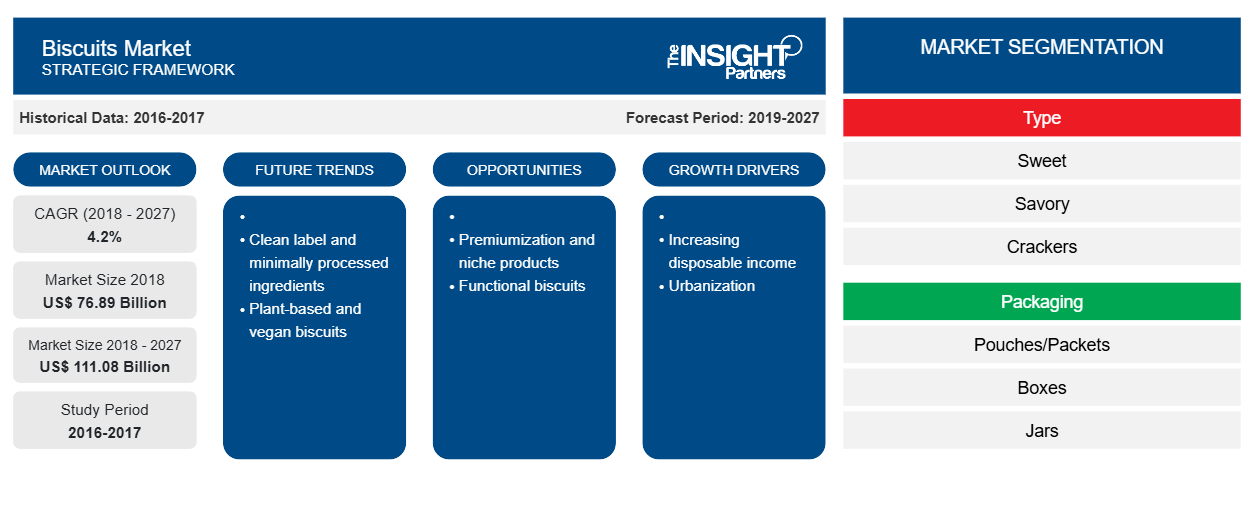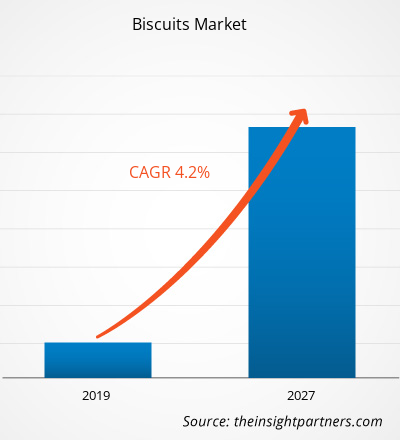[研究报告] 2018 年饼干市场价值为 768.86 亿美元,预计到 2027 年将达到 1110.7929 亿美元;预计 2019 年至 2027 年的复合年增长率为 4.2%。
饼干是用面粉、糖或盐、黄油或植物起酥油和发酵粉(作为发酵剂)混合制成的小块面包。市场上有各种各样的饼干,例如甜饼干、咸饼干、消化饼干和夹心饼干等。消化饼干富含纤维,是那些想避免食用糖和果糖玉米糖浆的消费者的首选。饼干含有许多营养成分,如脂肪、纤维和碳水化合物,这些都是人体健康所必需的。饼干的高营养价值使其成为全球最受欢迎的早餐食品。对方便零食的需求不断增加,加上健康饼干选择的普及等因素推动了全球饼干市场的增长。此外,外带食品的兴起趋势是消费者购买食品时的基本考虑因素之一,因此它已成为推动市场发展的有利因素。此外,为了吸引消费者,基础产品中频繁推出新配方,如无麸质、低脂、低碳水化合物、高纤维和有机饼干,进一步促进了市场增长。根据类型,饼干市场细分为甜味、咸味、薄脆饼干、夹心饼干、薄饼等。根据包装,饼干市场细分为袋装/小包、盒装和罐装。根据分销渠道,市场细分为超市和大卖场、便利店、在线零售等。
预计在预测期内,亚太地区将在全球饼干市场中实现最高的复合年增长率,达到 4.8%。许多国内外公司在该地区都站稳了脚跟。中国在亚太地区占据了很大的市场份额,其次是印度和日本。该地区通过有效的制造和贸易政策,在很大程度上支持了饼干市场的增长,消费者口味偏好的变化和对加工食品的需求不断增长,以及众多产品种类的供应推动了亚太地区饼干市场的增长。此外,由于人们对方便食品或便携零食的偏好不断提高,零食类饼干的需求不断增长,进一步推动了该地区饼干市场的发展。产品包装的创新在亚太地区饼干需求增长中发挥着重要作用。
定制此报告以满足您的需求
您可以免费定制任何报告,包括本报告的部分内容、国家级分析、Excel 数据包,以及为初创企业和大学提供优惠和折扣
- 获取此报告的关键市场趋势。这个免费样品将包括数据分析,从市场趋势到估计和预测。
COVID-19 疫情对饼干市场的影响
COVID-19 疫情于 2019 年 12 月首先在中国武汉爆发,此后迅速蔓延至全球。截至 2020 年 3 月,就确诊病例和报告死亡人数而言,中国、意大利、伊朗、西班牙、韩国、法国、德国和美国是受影响最严重的国家。由于封锁、旅行禁令和企业停业,COVID-19 疫情影响了各国的经济和行业。由于工厂关闭,COVID-19 导致的整体市场崩溃也影响了饼干市场的增长,供应链出现障碍以及世界经济衰退。
使用优质原材料,清洁标签趋势日益流行
选择优质原材料是标准化生产的一个重要方面,跨国企业需要投资以获得清洁标签。为了生产出所需品种和质量的饼干,公司正在努力选择质量最好的面粉和基本原材料,并持续供应相同的优质产品。由于饼干产品不是必需品,因此有吸引力的成分和健康益处或相关功能可以帮助生产商赢得消费者的关注。公司还关注包装的外观,这有助于产品的销售。此外,出口饼干产品的包装质量和产品是否适合不同出口国人民的口味也会影响饼干制造商的国际业务。因此,公司正在寻求在生产和包装中使用优质原材料,以确保更大的市场份额。
基于类型的市场洞察
根据类型,饼干市场分为甜味、咸味、薄脆饼干、夹心饼干、威化饼干和其他饼干类型。2018 年,甜味饼干占据了全球饼干市场的最大份额;预计在预测期内,夹心饼干市场将以最高的复合年增长率增长。甜饼干因其口味、能量含量和易得性而受到全球消费者的青睐。甜饼干的高营养成分也使其成为消费者的首选。此外,人们对方便零食的日益偏爱,加上消费者通过不断发展的零售业轻松获得零食,都有利于甜饼干市场的增长。
基于包装的市场洞察
根据包装,饼干市场分为袋装/小包、盒装和罐装。2018 年,袋装/小包占据了全球饼干市场的最大份额,而盒装预计在预测期内将实现最快的复合年增长率。饼干包装主要是为了以有吸引力的方式展示饼干,展示饼干的类型、成分和重量,保持饼干的新鲜度和风味以延长保质期,并保护饼干免受外部伤害等。此外,用袋装或小包包装饼干可以增加美观度,吸引顾客或有助于轻松识别。
基于分销渠道的市场洞察
根据分销渠道,饼干市场分为超市和大卖场、便利店、在线零售和其他分销渠道。2018 年,超市和大卖场占据了最大的市场份额,而在线零售市场预计在预测期内将实现最高的复合年增长率。超市和大卖场是自助商店,提供各种各样的饼干,如甜饼干、咸饼干、薄脆饼干、夹心饼干或涂层饼干以及威化饼。超市和大卖场提供广泛的商品组合以及不同品牌的饼干,并放在同一屋檐下。超市和大卖场有专门的饼干区,因此顾客很容易被引导到一个地方从各种各样的饼干中进行选择。因此,消费者更喜欢在超市和大卖场购买饼干产品。此外,发达国家和发展中国家大型超市和大卖场连锁店的存在促进了饼干通过这一渠道的销售。
合并和收购是公司为扩大其全球业务而采用的常见策略。Britannia Industries Limited、Burton's Biscuit Company 和 Mondelez International, Inc. 是实施此策略的市场参与者之一,旨在扩大客户群并在全球范围内获得显着的市场份额,这反过来又使他们能够在全球市场上保持其品牌名称。
饼干市场区域洞察
Insight Partners 的分析师已详尽解释了预测期内影响饼干市场的区域趋势和因素。本节还讨论了北美、欧洲、亚太地区、中东和非洲以及南美和中美洲的饼干市场细分和地理位置。

- 获取饼干市场的区域特定数据
饼干市场报告范围
| 报告属性 | 细节 |
|---|---|
| 2018 年市场规模 | 768.9 亿美元 |
| 2027 年市场规模 | 1110.8亿美元 |
| 全球复合年增长率(2018 - 2027) | 4.2% |
| 史料 | 2016-2017 |
| 预测期 | 2019-2027 |
| 涵盖的领域 | 按类型
|
| 覆盖地区和国家 | 北美
|
| 市场领导者和主要公司简介 |
|
饼干市场参与者密度:了解其对商业动态的影响
饼干市场正在快速增长,这得益于终端用户需求的不断增长,而这些需求又源于消费者偏好的不断变化、技术进步以及对产品优势的认识不断提高等因素。随着需求的增加,企业正在扩大其产品范围,进行创新以满足消费者的需求,并利用新兴趋势,从而进一步推动市场增长。
市场参与者密度是指在特定市场或行业内运营的企业或公司的分布情况。它表明在给定市场空间中,相对于其规模或总市场价值,有多少竞争对手(市场参与者)存在。
在饼干市场运营的主要公司有:
- 不列颠尼亚工业有限公司
- 伯顿饼干公司
- 国贸有限公司
- 凯洛格公司
- Lotus Bakeries NV
免责声明:上面列出的公司没有按照任何特定顺序排列。

- 获取饼干市场顶级关键参与者的概述
饼干市场——按类型
- 甜的
- 咸味的
- 饼干
- 已填满
- 晶圆
- 其他的
饼干市场 – 按包装分类
- 袋/包
- 盒子
- 罐子
饼干市场 – 按分销渠道
- 超市和大卖场
- 便利店
- 网上零售
- 其他的
公司简介
- 不列颠尼亚实业有限公司。
- 伯顿饼干公司
- 德丰有限公司
- 凯洛格公司
- Lotus Bakeries NV
- 亿滋国际
- 雀巢公司
- 联合饼干(英国)有限公司
- Parle 产品私人有限公司
- 沃克斯酥饼有限公司
- 历史分析(2 年)、基准年、预测(7 年)及复合年增长率
- PEST 和 SWOT 分析
- 市场规模价值/数量 - 全球、区域、国家
- 行业和竞争格局
- Excel 数据集



Report Coverage
Revenue forecast, Company Analysis, Industry landscape, Growth factors, and Trends

Segment Covered
This text is related
to segments covered.

Regional Scope
North America, Europe, Asia Pacific, Middle East & Africa, South & Central America

Country Scope
This text is related
to country scope.
常见问题
In 2018, the biscuits market was predominant in Asia Pacific at the global level. The demand for biscuit is expected to increase in the region with the rising demand from the food and beverage industry. Moreover, availability of flavors, such as chocolate, butter cream and peanut butter, is expected to contribute to the growth. Also, urbanization, rising disposable income and changing lifestyle further boost the biscuit market in the Asia Pacific region.
The major players operating in the global biscuits market are Britannia Industries, Burton’s Biscuit Company, ITC limited, Kellogg Company, Lotus Bakeries, Mondelez International, Nestlé S.A.; among many others.
The growth of the sweetsegment is primarily attributed to the growing preference for convenient snacking, together with easier accessibility of consumers through the advancing retail sector is favoring the demand for sweet biscuits, globally. The high nutrient content of sweet biscuits also makes it a preferred choice of consumers.Innovative packaging solutions and exotic flavors like chocolate confectionery, has made sweet biscuits the pioneer in premium snack offering, worldwide
Trends and growth analysis reports related to Food and Beverages : READ MORE..
The List of Companies - Global Biscuits Market
- Britannia Industries Limited
- Burton's Biscuit Company
- ITC Ltd.
- Kellogg Company
- Lotus Bakeries NV
- Mondelez International, Inc.
- Nestlé S.A
- United Biscuits (UK) Limited
- Parle Products Pvt. Ltd.
- Walkers Shortbread Ltd.
The Insight Partners performs research in 4 major stages: Data Collection & Secondary Research, Primary Research, Data Analysis and Data Triangulation & Final Review.
- Data Collection and Secondary Research:
As a market research and consulting firm operating from a decade, we have published and advised several client across the globe. First step for any study will start with an assessment of currently available data and insights from existing reports. Further, historical and current market information is collected from Investor Presentations, Annual Reports, SEC Filings, etc., and other information related to company’s performance and market positioning are gathered from Paid Databases (Factiva, Hoovers, and Reuters) and various other publications available in public domain.
Several associations trade associates, technical forums, institutes, societies and organization are accessed to gain technical as well as market related insights through their publications such as research papers, blogs and press releases related to the studies are referred to get cues about the market. Further, white papers, journals, magazines, and other news articles published in last 3 years are scrutinized and analyzed to understand the current market trends.
- Primary Research:
The primarily interview analysis comprise of data obtained from industry participants interview and answers to survey questions gathered by in-house primary team.
For primary research, interviews are conducted with industry experts/CEOs/Marketing Managers/VPs/Subject Matter Experts from both demand and supply side to get a 360-degree view of the market. The primary team conducts several interviews based on the complexity of the markets to understand the various market trends and dynamics which makes research more credible and precise.
A typical research interview fulfils the following functions:
- Provides first-hand information on the market size, market trends, growth trends, competitive landscape, and outlook
- Validates and strengthens in-house secondary research findings
- Develops the analysis team’s expertise and market understanding
Primary research involves email interactions and telephone interviews for each market, category, segment, and sub-segment across geographies. The participants who typically take part in such a process include, but are not limited to:
- Industry participants: VPs, business development managers, market intelligence managers and national sales managers
- Outside experts: Valuation experts, research analysts and key opinion leaders specializing in the electronics and semiconductor industry.
Below is the breakup of our primary respondents by company, designation, and region:

Once we receive the confirmation from primary research sources or primary respondents, we finalize the base year market estimation and forecast the data as per the macroeconomic and microeconomic factors assessed during data collection.
- Data Analysis:
Once data is validated through both secondary as well as primary respondents, we finalize the market estimations by hypothesis formulation and factor analysis at regional and country level.
- Macro-Economic Factor Analysis:
We analyse macroeconomic indicators such the gross domestic product (GDP), increase in the demand for goods and services across industries, technological advancement, regional economic growth, governmental policies, the influence of COVID-19, PEST analysis, and other aspects. This analysis aids in setting benchmarks for various nations/regions and approximating market splits. Additionally, the general trend of the aforementioned components aid in determining the market's development possibilities.
- Country Level Data:
Various factors that are especially aligned to the country are taken into account to determine the market size for a certain area and country, including the presence of vendors, such as headquarters and offices, the country's GDP, demand patterns, and industry growth. To comprehend the market dynamics for the nation, a number of growth variables, inhibitors, application areas, and current market trends are researched. The aforementioned elements aid in determining the country's overall market's growth potential.
- Company Profile:
The “Table of Contents” is formulated by listing and analyzing more than 25 - 30 companies operating in the market ecosystem across geographies. However, we profile only 10 companies as a standard practice in our syndicate reports. These 10 companies comprise leading, emerging, and regional players. Nonetheless, our analysis is not restricted to the 10 listed companies, we also analyze other companies present in the market to develop a holistic view and understand the prevailing trends. The “Company Profiles” section in the report covers key facts, business description, products & services, financial information, SWOT analysis, and key developments. The financial information presented is extracted from the annual reports and official documents of the publicly listed companies. Upon collecting the information for the sections of respective companies, we verify them via various primary sources and then compile the data in respective company profiles. The company level information helps us in deriving the base number as well as in forecasting the market size.
- Developing Base Number:
Aggregation of sales statistics (2020-2022) and macro-economic factor, and other secondary and primary research insights are utilized to arrive at base number and related market shares for 2022. The data gaps are identified in this step and relevant market data is analyzed, collected from paid primary interviews or databases. On finalizing the base year market size, forecasts are developed on the basis of macro-economic, industry and market growth factors and company level analysis.
- Data Triangulation and Final Review:
The market findings and base year market size calculations are validated from supply as well as demand side. Demand side validations are based on macro-economic factor analysis and benchmarks for respective regions and countries. In case of supply side validations, revenues of major companies are estimated (in case not available) based on industry benchmark, approximate number of employees, product portfolio, and primary interviews revenues are gathered. Further revenue from target product/service segment is assessed to avoid overshooting of market statistics. In case of heavy deviations between supply and demand side values, all thes steps are repeated to achieve synchronization.
We follow an iterative model, wherein we share our research findings with Subject Matter Experts (SME’s) and Key Opinion Leaders (KOLs) until consensus view of the market is not formulated – this model negates any drastic deviation in the opinions of experts. Only validated and universally acceptable research findings are quoted in our reports.
We have important check points that we use to validate our research findings – which we call – data triangulation, where we validate the information, we generate from secondary sources with primary interviews and then we re-validate with our internal data bases and Subject matter experts. This comprehensive model enables us to deliver high quality, reliable data in shortest possible time.


 获取此报告的免费样本
获取此报告的免费样本